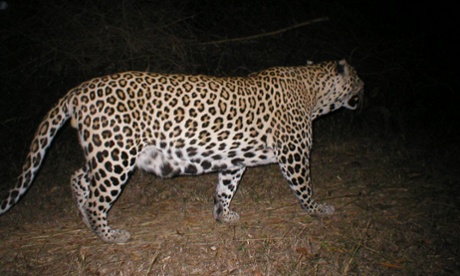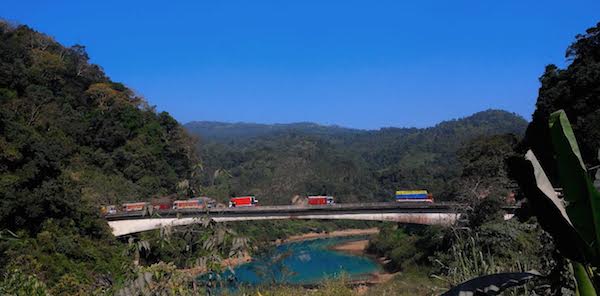Powder puff clouds built up during the June day, but then wafted away across the sky above Agumbe, Karnataka. When thunder roared late in the afternoon, my head snapped skywards. Had the monsoon arrived? The heavens rumbled promises they didn’t keep. Newspapers said the monsoon had set in over Kerala but wasn’t moving north.
At night, the forest resounded with a symphony of frog calls. They chirped, belled, croaked and clicked from the grass, low bushes, and the canopy. It sounded like a monsoonal night, except there was no rain.
Ramprasad, a researcher studying these amphibians at the Agumbe Rainforest Research Station (ARRS), pointed to puddles where newly metamorphosed, dark brown torrent frogs hopped out. Small, bright green male Malabar gliding frogs with hibiscus-red feet straddled large females in mating embraces. A couple of pairs of gliding frogs had already whipped up meringue-like nest balls that hung above a pond. A tree toad plopped down on the forest floor from a height. The night belonged to the amphibians.
Pre-monsoon showers may have greened the landscape and made frogs amorous, but the soil ached for a four-month-long soak. This is an El Nino year, and weathermen predicted the rains will deliver less than their normal quantum. Would it make a difference to Agumbe, a place famous for its copious rainfall, an average of 7,500mm in a normal year?
At dawn, birds began singing even as frogs continued their vocal din. The whistling thrush’s unhurried, rambling tune harmonised with racket-tailed drongos’ brisk, metallic, multi-timbral chatter. Fairy-bluebirds flashed their lapis shoulders as they flitted around fruiting bushes. Crimson-breasted Malabar trogons kept a low profile on the forest edge. The day grew brighter, revealing blue skies, and the night’s illusion of monsoon vanished.
It was the end of the jackfruit season. Many lay squashed on the ground, a feast for animals from elephants to squirrels and rats. A few remaining fruits hung pendulously from tree trunks. A fragrantly ripe one hung low, and Ram pulled it down. Milky sap collected around the broken stalk.
Squatting on the ground, he grasped the fleshy end of the fruit and pulled it apart. The bulbs were small and thin. I popped one in my mouth. It was fibrous, soft and unchewable. I spat out the large seed and swallowed the delectable flesh whole. This was not the familiar jackfruit, but a wild cousin.
Inch-long leeches made their way towards us, sensing the air occasionally with the narrower end of their linear bodies to zero in on their targets. I flicked them off with one hand, while digging into the sticky fruit with the other. By the time I had a few pieces, Ram had demolished half the fruit, and his hands and stubble-covered face were smeared in white latex. I’ve been known to hog a whole jackfruit by myself, and I began to see a competitor in Ram. I’d have to be faster and less decorous. But Ram left the other half on the ground and rose, suggesting, “We’ll leave the rest for the animals.” I acquiesced.
At the first homestead, we stopped to clean up and quench our thirst. Our hosts didn’t comment on the obvious signs of our jungle repast. Bidding them farewell, we returned to the research station.
Clouds gathered, and by evening, it began raining in earnest. In the village, many houses were already covered with tarpaulin sheets against the prevailing wind. Some followed tradition — areca fronds skilfully woven through a wooden frame to form a watertight barrier. But many tardy households were still repairing their roofs, and rains must have been unwelcome.
After dinner, I contemplated going for a walk. But Ajay Giri, the station’s education officer, received an urgent call. A king cobra had gone to sleep under a bed in a village house about 60km away. The decrepit jeep’s headlights and windscreen wiper didn’t work. At least the yellow fog lights did, but it took us two hours to reach the village. Women and children were already tucked indoors, and a crowd of about 30 men, most of them exhaling fumes of alcohol, awaited us.
The men ushered us to a tiny house. Firewood and bales of leaf litter to spread in the barns lay covered in plastic. Cow dung patties to be used as fuel lay in piles. Inside, pickles cured in large porcelain jars, while stacks of dry appalams sat on kitchen shelves. From the rafters, rotund Madras cucumbers hung from strings. Young green jackfruit and mangoes, gourds, and bamboo shoots were preserved in salt.
Once the monsoon hit, vegetables would become scarce, and families in this region will live on a diet of fresh edible leaves from the kitchen garden and Madras cucumbers. Appalams, pickles and salted preserves made into chutneys would provide the only variety.
A large king cobra lay in a tight coil under the bed and hissed softly when the torchlight shone on his face. I didn’t want to be in a furniture-crammed house with a soon-to-be-agitated snake and 30 men blocking the door. I opted to stay outdoors, while Ajay directed the snake into a gaping jumbo-sized snake bag. One of the men, a retired policeman, kept me company. He had served in Kosovo on a UN Peacekeeping Mission. He spoke about 10 words of English and my Kannada was worse.
After Ajay bagged the snake, he gave the gathered crowd a talk on the species and the need to release it close by. Freeing it far away would likely sentence it to death, he said, quoting a research study. It was well past midnight before Ajay had answered all their questions. Forest Department officials escorted us to a forest a kilometre away. Ajay opened the bag, and the 11-foot snake disappeared into the darkness.
Over the following days, the weather followed the same pattern: sunny mornings, cloudy afternoons and rainy evenings.
I asked Kasturiakka, a matriarch who lived in Agumbe’s famous 200-year-old family home, Dodda Mane, the setting for the much-loved television series Malgudi Days, if villagers worshipped for rain. She said, “Yes, at the Rishya Shringeswara temple in Kigga.”
“Do people ever request god to stop the rains?” I asked.
“Of course,” she said. “They worship at the same temple. But the monsoons were heavier 20 years ago.”
I expected the name Agumbe, a place that considers 7,500mm of rainfall normal, to mean ‘where the rains dump their goods’. Even Rishya Shringeswara, the sage who could summon Indra, the god of rains, presided 35km away. Kasturiakka corrected me, “Agumbe is short for Madagumbapura. It means ‘the place with lots of elephants’.”
That was surprising. There were no elephants in Agumbe until six years ago, when two bulls from Chikmagalur started making annual visits.
“There was a massive forestry operation in the old days. Lots of captive elephants were used to fell trees and move logs,” said Kasturiakka.
Later, I dropped in to see Vamanna, the local weatherman. He has maintained records from 1962, also the year of the highest rainfall in 52 years: 11,343mm. I struggled to imagine what over 35 feet of rain could be like. He offered an understatement: “The road was blocked.”
One afternoon, rains came down with force and mist wafted down from the sky. In the evening, winged termites emerged from the ground. Some flew upwards on their nuptials, while most crash-landed nearby, unable to get airborne. It was raining too hard for any predators to home in on this meal. Moments later, I grew aware of another kind of water rushing. A stream that had been dry had started to gush. To me, swarming termites and rushing stream personified monsoon.
“This is not the monsoon,” said a recent arrival at the station. “Monsoon arrives with a lot of thunder and lightning.”
A veteran countered, “That’s pre-monsoon. The monsoon arrives with wind only.”
According to the weathermen, it’s officially monsoon when it has rained for over 48 hours with a westerly wind speed of 27 to 37kmph. This is the way the monsoon arrives, not with a bang but inexorably blown in.
That humid night was deafening with sounds of a frog orgy. Their mottled glistening skins shone brightly in torchlight. A dark Malabar pit viper, resembling lichen, coiled around a stick on the path, waiting to ambush a passing frog, even as the rain beat down on it.
Early the next morning, I waited for a taxi to the airport. I wondered if the driver would arrive on time with the rain pelting down and mist reducing visibility. As the watch ticked, I considered my meagre options. The jeep would not get me to the airport in time. It was either the taxi or a missed flight. I stared at the misty blankness. Was this the monsoon finally? A phone call broke my reverie. The driver said a fallen tree obstructed the road.
I woke up Ajay and he drove me the few hundred metres to the tree. The only way to get to the other side was to squeeze through the barbed-wire fence protecting a Forest Department cane and guava plantation, circumvent most of the prone tree crown, crawl back out through the fence, and scramble over a few branches.
I reached the airport just in time, with red earth crusted around my toes, disreputable flip-flops, damp bags and a lingering smell of jackfruit on my hands. The monsoon had well and truly arrived.
(Janaki Lenin writes on wildlife and conservation. Her last book was My Husband and Other Animals.)
(This article was published on July 11, 2014)






